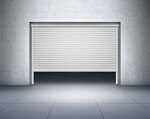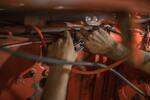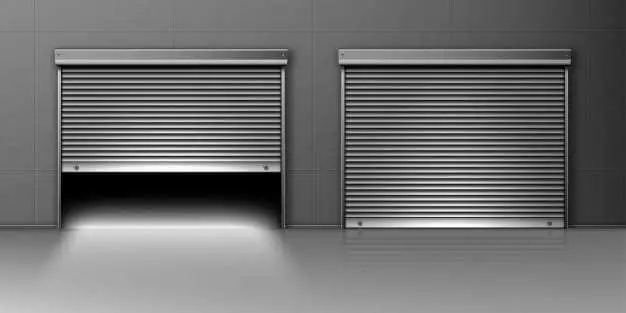Your garage door system consists of several components that ensure the flawless functioning of the door. And garage door cable is one of these components. So, it’s essential to repair it as soon as you find out there is some issue with it. You can call a professional or opt for garage door cable repair do it yourself, depending on the problem.
If your garage door cable is broken/isn’t working properly, and you’re looking for ways to fix it by yourself, you’ll definitely find the garage door cable repair do it yourself tips we’ll discuss in this article helpful.
However, it’s important to know that repairing a garage door cable by yourself can be pretty dangerous in some cases. So, it’s better to call a professional service when you’re not sure you can fix the cable issues.
The Purpose of Garage Door Cable
Before you repair your garage door cable, it’s important to know the role it plays in your garage door system.
A garage door cable is a twisted wire that is galvanized and attached to the torsion spring from one end. The other end connects to the garage door frame. This cable, along with the spring, ensures the seamless opening of the door. And it also reduces tension on the springs, which helps prolong their life.
Another crucial role of the cable is to prevent the springs from flying around in case they break. Moreover, when the springs break, the garage door can slam shut. And this can cause serious damage to you or your car. But if your garage door cable is working properly, it will prevent the door from slamming even if the springs break.
Useful Tips for Garage Door Cable Repair Do It Yourself
Here are some important tips that will help you repair your garage door cable by yourself.
Understanding different types of garage door cables
Before you start repairing your garage door cable, you need to know the type of cable your garage door uses.
Torsion spring cables
Torsion spring cables are also called lifting cables as they help lift the garage door along with torsion springs. Most garage doors now usually use torsion springs because they are more durable than other types of cables. And they are also better at maintaining the smooth operation of the door.
Torsion springs require torque to work and are connected to the drum. The cable is connected to the bottom bracket on each side of the door. And it wraps around the drum to open and close the door.
Basically, the purpose of the spring is to provide the required force while the cable helps lift the door. And the drums are essential for keeping the door balanced.
Torsion spring cables are available in different diameters; usually, the less the diameter, the quieter the operation. It’s because thick cables cause noise when they wrap around the drum as the door opens.
7×7 cables with 1/8- inch diameter can generally withstand a weight of up to 1,600 pounds. But these cables can produce noise as they wind around the drums. Another option is to use 1/8-inch cables with a 7×19 strand. These cables have more weight capacity, around 1950 pounds, and also don’t produce much noise.
For an even quieter operation, it’s best to use thinner torsion spring cables with a diameter of 3/32-inch. The weight capacity of these cables is around 950 pounds, which is usually enough for most standard garage doors. But you should always evaluate the weight of your garage door before using any type of cable.
Extension spring cables
Extension spring cable is another type of lifting cable that is used along with extension springs to lift the door. The springs are attached on each side of the garage door. The cable runs over the pulleys and connects to the springs. Unlike torsion springs, these springs expand and contract when the door opens or closes.
Most garage doors with extension springs usually use 3/32-inch cables, as they have enough weight capacity, around 950 pounds. If you want more weight capacity (up to 1950 pounds) and better flexibility, you can use 7×19 cables with a 1/8-inch diameter.
Some garage doors also use safety cables along with extension springs to keep the springs in place in case they break. These cables pass through each extension spring and connect to both ends of the garage door.
Generally, the life cycle of exertion springs is around 10,000 cycles, which means they will break at some point. So, if your safety cables are broken or damaged, it’s always better to repair/replace them quickly to prevent injuries/damage.
Common garage door cable issues
For garage door cable repair do it yourself, you first need to figure out the problem with the cable. Some of the most common garage door cable problems include:
- Cable is broken
Garage door cables can wear down over time and then eventually break. If this happens, you’ll know by looking at the cable.
- Cable slips off the drum
Several reasons can cause the cable to not wound around the drum properly or slip off. First of all, check if the diameter and length of the cables are right for your garage door. Also, check the size of the drum. Usually, tall doors require large drums.
Sometimes, issues with cables occur because the springs don’t have the right amount of tension. When the springs have too much tension, they can cause the cables to slip off the drums.
- Cable can become unwound
When the garage door cables become unwound, you need to replace them.
- Fraying cables
You can easily tell if your garage door cables are fraying by their appearance. And they need to be replaced immediately.
How to know there is some problem with your garage door cable
There can be many reasons why your garage door is not working properly. But if you detect any of these problems, it can be a hint there is something wrong with the cables.
- The door isn’t opening properly
If you notice your garage door is opening unevenly, first check the motor and springs. If the motor is working properly and springs are also in place, it can mean the cable is broken.
- Unbalanced door
If your garage door is leaning to one side, it’s usually because of loose cables. You can adjust the cables to deal with the issue. Sometimes frayed cables can also result in an unbalanced garage door.
- The door isn’t working at all
When your garage door cable or drum is broken, your garage door can stop working completely.
Some garage doors also come with safety features. So, when the cable is broken, the door stops moving to prevent damage.

- The door is closing too fast
If your garage door slams down or is closing faster than usual, broken or damaged cables can be the culprit.
- Cable hanging loose
When the garage door cable snaps, you can usually see it hanging loose beside the garage door.
Quick Garage Door Cable Repair Do It Yourself Guides
Here are a few quick guides to help you repair your garage door cables by yourself.
Replacing garage door cables
Tools you’ll need:

- First of all, open the door and lock it in place. To open the door manually, you’ll have to pull the emergency release handle. This will disengage the door opener. You can use vice grips below the bottom roller to hold the door in place.
- Now, remove the tension on the springs by unwinding the springs. To do so, you’ll have to loosen the screws of the springs. Always insert the winding bars fully to avoid safety hazards. Also, check if your garage door has two springs. If so, repeat these steps for the other spring as well.
- Remove the cable from the drum by loosening the screws of the drum using a wrench.
- Next, remove the cable from the bottom bracket. You can use a socket wrench to remove the screw on the bracket.
- Once the cable is fully removed, you can start installing the new one. First, attach the new cable to the bottom bracket and wind it over the drum. Remember to rotate the drum anticlockwise to tighten the cable. Lastly, secure it with screws.
- It’s always better to replace both the cables even if only one of them is broken. This way, you can ensure both the cables are the same.
- Lastly, increase the tension on the springs with the help of winding bars. Remember to pull down the emergency release handle to re-engage the door.
- New garage door replacement cables
- Vice grips
- Socket wrench
- Winding bars
Tightening loose garage door cables
Tools you’ll need:
- C-clamps
- Pliers

- First, close the garage door fully using the automatic control. If you see a small gap between the garage door and the ground, it’s because of the loose cables.
- Disengage the door by pulling down the red cord. This will release the door from the drive chain and put it in manual mode.
- Open the door manually with your hands and secure it using clamps. Some garage doors come with clamps on the track. Or you can use c-clamps if your door doesn’t already have clamps. Some garage doors also have a metal lock that you can slide into the track to hold the door in place when you open it.
- If the cable has come off the pulley completely, simply wind it around the pulley using your hands. While wrapping the cable, make sure it’s tight. Remember, the springs will put tension on the cable, and it will get tighter once you re-engage the door.
- If your garage door cable is loose, start with adjusting the cable bracket. If you still notice slack on the cable, you’ll have to loosen the bracket that holds the cable to the hook. You’ll need pliers for this purpose. Now, pull the cable through the bracket and tighten the bracket. Lastly, attach the cable back to the frame.
- Remember to re-engage the door opener by closing the door and pulling the red cord.
Is Garage Door Cable Repair Do It Yourself Safe?
Repairing garage door cable by yourself requires you to be very careful because it can be dangerous if you don’t follow the instructions properly. Tightening loose cables is easy and doesn’t involve as much risk as replacing the cables.
Moreover, extension spring cables are easier to replace compared to torsion spring cables. It’s because torsion springs are under a lot of tension. So, if something goes wrong, it can result in spring flying across the garage, which can cause serious injuries. Also, there is a risk of falling garage doors whether you’re replacing extension spring cables or torsion spring cables. So, if you feel you’re unable to repair the garage door cable, call a professional service.
Final Thoughts
A garage door cable is an important component of the garage door system because of several reasons. It helps with the smooth operation of the door and also keeps the springs from flying if they break. So, if there is some problem with your cable, you need to repair it as soon as possible. If you opt for garage door cable repair do it yourself, it’s better to first understand the different types of cables. These include extension spring cables, torsion spring cables, and safety cables. Also, always take the required safety precautions, and follow the instructions properly.
Moreover, before repairing the cable, you need to figure out the issue first. Common garage door cable issues include broken or frayed cables, cable slipping off the drum and loose cables, etc.
Are you looking to clean your pool quickly and easily without spending too much money? Check out our article on Do It Yourself Pool Cleaning.


